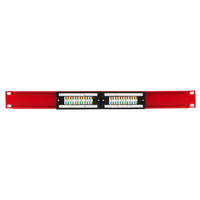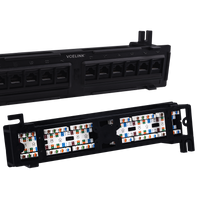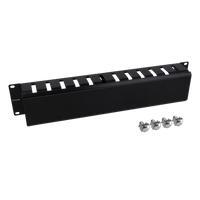Introduction
A patch panel plays a key role in keeping an organized network structure. But should you pick a shielded patch panel or an unshielded patch panel? In a few minutes, we’ll see how each option works, where each stands out, and how to decide. This matters regardless of whether you’re wiring a small office or racking gear for a high-density Cat6 patch panel deployment.
What is a Patch Panel?
A patch panel (sometimes called a cross-connect) is a hardware device that terminates horizontal cabling on the back and features labeled ports (typically RJ-45) on the front. It is like a central hub for terminating network cables. Instead of connecting each device to a network switch or wall outlet, the patch panel is like an intermediary point (a layer of connection) that prevents tangled cables and an undecipherable mess of wires.
The main function of patch panels is to aggregate several network cables coming from diverse locations (server racks, workstations, meeting rooms, etc.) into a single location.
Before the appearance of patch panels, network installations usually implied terminating the cables at switch ports. But if it was necessary to move a workstation, add a new device, or troubleshoot a faulty cable, it required accessing the switch. This often caused disruptions to active connections, was time-consuming, prone to mistakes, and put excessive stress on switch ports. And a damaged switch port can spoil the entire switch. This was time-consuming and costly.
Today, with patch panels, instead of terminating cables directly at the switch, you:
- Terminate permanent links once on the panel.
- Use short patch cords to connect switch ports as needed.
That means faster moves, adds, and modifications, and no technician behind racks each time. Therefore, if you plan to wire a home network or a small office, choosing the right Cat6 patch panel, shielded or not, will determine how well your network performs.
Patch panels types
- By Ethernet cable category- Cat5e, Cat6, and Cat6a patch panel. Note that a Cat6 patch panel can work with Cat6 or lower.
- By cable structure – Unshielded patch panel and shielded patch panel.
- By port loading – Preloaded and unloaded keystone patch panel.
- By connection type – RJ11, RJ12, and RJ45 patch panel.
- By installation method – Rack Mount and Wall Mount patch panel
Now that you have a general idea of patch panels, we’ll focus on the differences between shielded patch panel and unshielded patch panel.
The Shielded Patch Panel
A shielded patch panel comes with a conductive layer that protects against electromagnetic interference (EMI) and radio frequency interference (RFI). This conductive layer is usually made of braided mesh or foil.
Shielded patch panels are created to terminate FTP (Foiled Twisted Pair), SFTP (Shielded Foiled Twisted Pair) Ethernet cables, and some other shielded variants.
It’s important to ground a shielded patch panel properly. Proper grounding ensures that electromagnetic interference is directed away from the conductors. This preserves signal integrity. Grounding is simply connecting the panel’s shielding to a grounding point through a grounding wire.
Key advantages
- Superior EMI protection – Essential near variable-frequency drives, medical imaging equipment, or broadcast studios.
- Better support for high-power PoE – The shield disperses heat and reduces resistance imbalance.
- Steady performance at 10 GbE over Cat 6A links in electrically noisy spaces.
When to use it:
- With Cat6a or higher cables for speeds of 10 Gbps and more.
- In industrial settings with large motors or welding gear.
- In data centers that mix copper cables with high-density power busways.
- In hospitals or airports where regulations demand shield continuity testing.
- For outdoor or exposed installations.
Important note: For outdoor installations, use outdoor-rated cables first. Shielding can be optional in environments with low EMI, but will always help to reduce currents from nearby electrical sources.
Expert Tip: Always ensure your entire system is shielded. If you mix shielded and unshielded components, this can increase noise due to improper grounding.

The Unshielded Patch Panel
An unshielded patch panel is a network patch panel type that doesn’t have any internal shield around the internal wiring to protect against electromagnetic and radio frequency interference.
Unshielded panels are built to be used with unshielded twisted-pair cables.
Key advantages
- Lower cost – Fewer materials and a simpler ground scheme cut the expenses.
- Easier installation – They don’t require a drain wire or bonding bar to terminate.
- Adequate noise protection – Twisted-pair still cancels most crosstalk for typical office EMI (electromagnetic interference).
When to use it
- In small offices with standard PoE phones or access points
- With standard Ethernet speeds of up to 5 Gbps on Cat6, 2.5 Gbps on Cat 5e, and 10 on Cat6 a for shorter runs.
- For domestic AV (audio and video) racks, where power cables are routed a few inches away
- For basic networking needs
- In silent indoor environments
- In a situation where the budget is limited.
Expert Tip: Keep your cable bundles at least 50 mm (≈2 in) from fluorescent ballasts or high-current conductors to reduce induced noise without shielding.

Side-by-Side Comparison
|
Feature |
Unshielded Patch Panel |
Shielded Patch Panel |
|
Noise protection |
Relies on twists; good for low-EMI rooms |
Full metal enclosure, excellent for harsh EMI |
|
Grounding |
Not required (code may still call for rack ground) |
Mandatory bonding at every panel |
|
Cable type |
UTP (Cat 5e /6/6a) |
F/UTP, S/FTP, SF/UTP, etc. |
|
Cost |
20–40 % less |
Higher material and labor cost |
|
Typical bandwidth |
1 GbE on Cat 5e/6; 10 GbE on Cat 6A UTP (shorter runs) |
10 GbE+ over Cat 6A/7 shielded, full channel length |
|
Ideal environments |
Offices, classrooms, SMB server rooms |
Factories, healthcare, broadcast, PoE++ |
Consider Which One Best Fits Your Needs.
First, check your environment. Take a walk around your space and see if there are potential sources of interference. (Flickering monitors or hearing a buzz near lights may indicate there’s interference.
Secondly, think ahead. You might not need 10 Gbps of speed today, but opting for a shielded Cat6 patch panel now may save you time and money in the future if you decide to expand or upgrade.
Installation Best Practices
1. Keep Patch Panel and Cable Category Aligned
Mixing a Cat6 patch panel with Cat 5e cords throttles the whole link. Always match or exceed the horizontal-cable rating.
2. Preserve Pair-Twist
Untwist no more than 13 mm (½ in) when punching down. Longer untwist = higher return loss.
3. Follow Bend-Radius Rules
UTP: 4× cable OD (≈1 in for Cat 6). Shielded: 8× OD to avoid kinks in foil.
4. Ground Once, Bond Many
On shielded runs, ground the rack to the main building entrance; bond every panel to that single point.
5. Label Everything
Front ports, rear IDC blocks, even the drain-wire termination. Future technicians (possibly you) will thank you.
Five Most Frequently Asked Questions
Let’s answer some of the most frequently asked questions about patch panels:
1.Can a shielded panel work with unshielded cables?
Yes, it’s physically possible, but you will lose the benefits. Unshielded cables can still pick up interference and disrupt the shielded patch panel’s protection.
2.Can I run POE++ on an unshielded patch panel?
You can, but watch for the heat building up in cable bundles, particularly with high-power PoE. Shielded patch panels and cables deal with heat much better, helping you keep network performance and cable durability.
Note: PoE++ is the most powerful version of PoE (Power over Ethernet), and provides 90 W under IEE spec, some vendors offer proprietary 100-watt modes.
3.Is a shielded solution worth the hassle and costs for a small office?
Usually not, unless there is a strong source of interference nearby. Most small offices do well with unshielded patch panels as they don’t have much electrical activity.
4.Can I mix Cat6 and Cat6a cables on the same patch panel?
You can, however, the speed for that specific link will be limited to the component of the lowest category. For example, a Cat6a cable connected through a Cat6 patch panel will work at Cat6 speeds.
5.How does a patch panel make troubleshooting easier?
It makes it easier as it provides a central point for all cable terminations. Technicians can easily test a cable run from the labeled front ports of the panel.
Conclusion
Choosing between an unshielded patch panel and a shielded patch panel isn’t about determining which one is better. Instead, it’s about finding out which one is “better for your environment.”
Unshielded is the solution to go with when you are on a budget and want a quick installation for an office or domestic setup in environments with low EMI.
A shielded patch panel is the ideal choice in environments where there’s high electrical noise, high-power PoE applications are used, or when requiring 10-gig workloads, as those are a menace to signal integrity. It’s also the one needed for outdoor installations.
With this information, assess your environment and networking needs, then make an informed decision.






Be the first one to comment.
Leave a comment